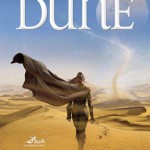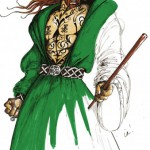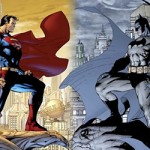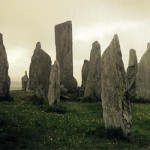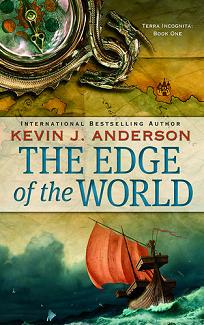
Title: Terra Incognita: Edge of the World
Author: Kevin J. Anderson
Publisher: Orbit
Release Date: June 8, 2009
Synopsis:
The known world consists of two large north/south continents held together by an isthmus. On this isthmus is the holy city of Ishalem. Ishalem isn’t just the holiest city for one religion, but two, and after a peace treaty is pledged on the holiest place in the holiest city, a devastating fire erupts. The tenuous peace between the vastly different cultures is immediately destroyed, each blaming the other. It’s almost poetic that the two clashing religions were started by siblings, because this sibling rivalry, like many others, continues to fuel itself for lack of parental guidance.
However, one element of the peace treaty remains: the world has been virtually cut in two. The Tierrans stay in the northern hemisphere, and the Urabans stay in the south. Of course, there will be border skirmishes and bad decisions made on both sides, but dividing the world spurred both sides into exploration. The Tierrans set out across the sea while their complete opposites set out across the desert to discover lost landmasses and lost peoples.
Review:
The premise here has a lot of promise, exploring vast uncharted territory, religious wars, and sea monsters, and on those counts it certainly delivers. If you’re looking for a broad-scoped action and adventure novel this summer (or anytime, really) this is a fun read, but great literature it is not. Before I delve into that, however, I do want to point out where this book succeeded for me.
Events of the book, including religious wars and a shared holy city with conflicting views about who should get the credit not only reference the Crusades, but the idea of a holy war really extends even to modern events. The story isn’t told from one side or the other. We don’t hear just from the Tierrans and about how they are morally superior; we see the events unfold from the Urabans’ perspective as well. It illustrates how easily misunderstandings can escalate into terrible consequences and how neither side is entirely in the right or in the wrong.
The scope of the story isn’t something that many authors would feel comfortable with. Rather than focusing on one or two characters through the one battle to save them all, you have a large ensemble of characters and an entire world to look at. This can have its drawbacks, which I’ll get into, but it was ambitious and I can certainly appreciate that. Also, who could say no to sea monsters?
What I would have liked to see more of is character development. I don’t care as much about world building beyond the basics needed for the story, and I don’t need pages and pages of description of the terrain or how someone looks when the sun hits them from the west and they’re turning counter clockwise. However, if the story is going to be told from different points of view, as this one is told from a different point of view every short chapter, I want to really get inside their heads. As a personal preference I would have preferred to spend more time with fewer characters. As it was, all of the characters seemed a little distant from me, so I couldn’t really care much about any one of them. I can appreciate wanting to show an impartial view of events, but I think that works better for the History Channel than it does for a fantasy novel.
Overall, griping aside, I was entertained. If you like action, exploration, and high seas adventure this will be a fun and quick read. I wanted more, and I can only hope that the next two books can deliver. I have to give this one a C, but I have high hopes for what will come next.


